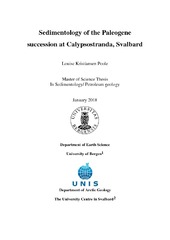| dc.description.abstract | The following study encompasses sedimentological investigations of the Calypsostranda Group. The Calypsostranda Group is comprised of Paleogene sediments where outcrops are well exposed in a coastal section at Renardodden (Calypsostranda area), on the southern shores of Bellsund in western Spitsbergen. The aim of the study is to: i) generate reliable depositional models for the evolution of the sediments of the Calypsostranda Group, through facies recognition and break-down ii) investigate and discuss source-to-sink perspectives including provenance and possible basin-development scenarios in accordance with different age datings and the tectonic history of western Spitsbergen. A limited amount of research has been conducted on the deposits of the Calypsostranda Group, however they are important to understand in the context of the regional sedimentation and tectonic history of western Spitsbergen. The succession encompasses delta plain sediments of the Skilvika Formation and paralic to marine sediments of the Renardodden Formation. Through sedimentological outcrop investigations, sixteen lithofacies have been identified from the studied sedimentary succession of the Calypsostranda Group (F1-F16) by means of facies recognition and break-down. The lithofacies were further grouped into seven sub facies associations, which can be divided into two main facies associations: i) a sub-aerial delta plain (Skilvika Formation) and ii) a paralic to marine regime (Renardodden Formation). The deposits in the Calypsostranda area were initially deposited in a prograding fluvial dominated, storm-wave influenced delta system. The fluvial dominance can be deduced from a number of observations; the abundancy of distributary channels on the delta plain, coarse-grained debris flow deposition from hyperpycnal flows on the delta front, mouth bar deposits and turbidites. The dominance of very-fine to fine-grained sand and abundancies of coal fragments in the marine deposits are indicators of a fluvial dominated system. The deposits have further been divided into a five-stage depositional model that involves a major transgressive phase drowning previously subaerial deposits, followed by normal regression with delta progradation. Evidence from the petrographical and sedimentological analysis points to a potential dual source area for the deposits in the Calypsostranda area. Findings of metasedimentary rock fragments, silica-rich biofragments and chloritoid in the thin sections account for a potential metamorphic basement derived source. In addition, a sand-rich system and coal fragments suggests an uplifted sedimentary source. Given the uncertainty of the ages of the deposits, three different palaeogeographical scenarios are presented and described. | en_US |
